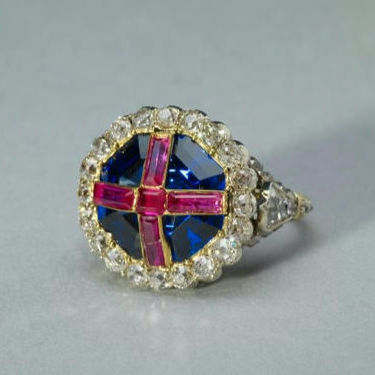Queen Victoria's sapphire coronet
- Victoria Regina
- Dec 29, 2023
- 3 min read
Updated: Jan 1, 2024
This coronet was designed by Prince Albert and given to Queen Victoria in 1840.

The earliest record of the ‘Small Coronet’ of diamonds and sapphires has been found by Shirley Bury in Queen Victoria’s private account book in a list headed ‘1842 – For Jewellery for myself’. The Queen ‘cited no maker’ but recorded the cost of the coronet as £415. It was purchased with a pair of diamond and sapphire earrings (of which half, £280, was paid by the Queen and the other half by Prince Albert), and a brooch and a bracelet of sapphires and diamonds which were priced together at £360.1
Its Gothic design is in the Romantic spirit, an inspiration to both Victoria and Albert who shared an admiration of Sir Walter Scott. The coronet holds similarity to Saxon Rauten Krone (Order Of The Rue Crown) which has often been associated with Prince Albert. Victoria often wore the coronet at an angle which the crown ran diagonally across the shield in the Saxon arm. The cresting is more complex in the sapphire coronet than in Albert’s book plate, which has only trefoils without intervening points, but other versions of the Rauten Krone frequently have the latter

Design sketches by Prince Albert
Royal Collection Trust / © His Majesty King Charles III 2023
The coronet is mounted with diamonds set in silver, with 11 step-cut sapphires of octagonal and calf’s head shape, set in gold. The piece was designed to match a sapphire and diamond brooch that Albert gave to Victoria the day before their wedding, perhaps kick-starting the Queen’s love of parures. Later Prince Albert would commission a bracelet and necklace to go with the set. The piece is made to allow the coronet to be manipulated to the wearers choice. Queen Victoria often wore it around her bun in her younger years, such as in Franz Winterhalters 1842 portrait of her. Later in life Queen Victoria would have the coronet much wider and placed upon her widows cap. Various royals including Princess Mary wore the tiara as a bandeau.

Queen Victoria 1842 by Franz Winterhalter
Royal Collection Trust / © His Majesty King Charles III 2023
Prince Albert played a part in the conception of the coronet is entirely in keeping with his close interest in Victoria’s jewels. When Victoria wrote in her Journal on Christmas Eve, 1842, ‘Splendid indeed were the presents my beloved one gave me, amongst them the rearrangement of some of my jewels, to be worn in different ways...’
In February 1843 Victoria described the care Albert took over the jewels: ‘We were very busy looking over various pieces of old jewellery of mine, settling to have some reset, in order to add to my fine “parures”. Albert has such taste, and arranges everything for me about my jewels'
Even into widowhood Queen Victoria still wore the coronet on occasions, it was one of the only tiaras with coloured gems she would wear after Alberts death. On The 6 February 1866, after the opening of Parliament for the first time since Prince Albert's death, she noted in her diary that she had worn an ordinary evening dress, her widow's cap with a flowing tulle veil and this 'small diamond and sapphire coronet'. The coronet can also be seen being worn upon her widows cap in a portrait by Henry Richard Graves in 1872.

All images Royal Collection Trust / © His Majesty King Charles III 2023
When Queen Victoria died in January 1901, the coronet passed to her son, King Edward VII. After his death in 1910, the jewel was inherited by his son, King George V. George and Mary decided to send the tiara to another branch of the royal family. When George and Mary’s only daughter, Princess Mary, Princess Royal married Viscount Lascelles (later the Earl of Harewood) in 1922, they gave Princess Mary the sapphire coronet as one of her wedding presents. They amplified the gift with additional sapphire jewels that had belonged to Queen Victoria, including the matching necklace and bracelet. In 1992 at the wedding of the 7th Earl of Harewood's son Mark Lascelles, his bride Andrea Kershaw wore the coronet as a bandeau.

Left to right- Princess Mary wearing the coronet in 1922, The Countess Of Harewood wearing the coronet 1977, Andrea Kershaw wearing the coronet at her wedding to George Lascelles in 1992, Princess Mary with Maria The Duchess Of Kent 1950's?
After the 7th Earl’s death in 2011, the family decided to sell the tiara. It was purchased by an anonymous buyer, who retained it for several years before deciding to sell the piece as well. The proposed buyer of the tiara was a foreign national, a detail which caught the attention of the British government. They decided in 2016 to step in and attempt to prevent the historic piece of jewellery from leaving the country. The minister of culture, Matt Hancock, imposed a temporary ban on the coronet’s sale by deferring the approval of an export license for the piece. The coronet is now on permanent display at The V&A museum.



Comments